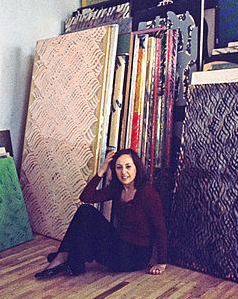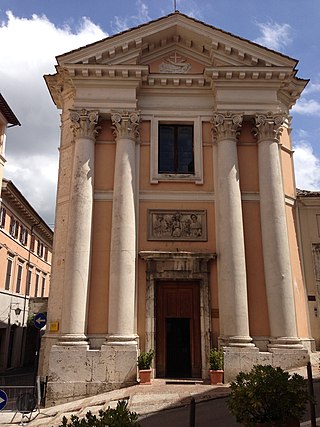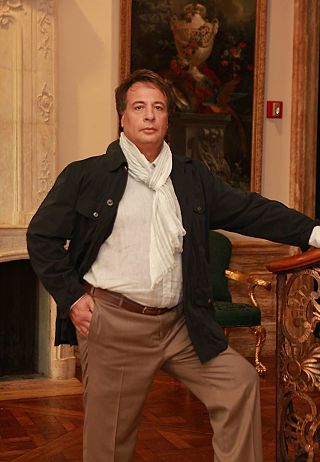
Alberto Sotio (... - fl. 1187), also Alberto Sozio, was an Italian painter and illuminator of medieval art from Spoleto, active during the second half of the twelfth century.

Alberto Sotio (... - fl. 1187), also Alberto Sozio, was an Italian painter and illuminator of medieval art from Spoleto, active during the second half of the twelfth century.
Alberto Sotio is considered the central figure of the twelfth century Spoleto school of painting. The master's signature (with handwriting Sotio), was found on the crucifix of the Cathedral of Spoleto in the lower part of the figure of the skull of Adam under the image of Christ with the date 1187, [1] and even further down and precisely on the end of the cross read a fragment of the text A. D. MCLXXXVII. M.... Opus. Alberto. Sotii .... [2] A precious work and in perfect conservation. [3] He is also attributed some of the frescoes in the former church of Santi Giovanni e Paolo, Spoleto. [4] A fragment from a crucifix attributed to him is a rare example of an early Italian painting, executed on parchment affixed to a wooden panel. This suggests that he may have also worked as a manuscript illuminator. [5] He is also credited with the fragment of the Madonna in Maestà, now preserved in the Pinacoteca di Brera. [6]

Spoleto is an ancient city in the Italian province of Perugia in east-central Umbria on a foothill of the Apennines. It is 20 km (12 mi) south of Trevi, 29 km (18 mi) north of Terni, 63 km (39 mi) southeast of Perugia; 212 km (132 mi) southeast of Florence; and 126 km (78 mi) north of Rome.

Achille Bonito Oliva is an Italian art critic and historian of contemporary art. Since 1968 he has taught history of contemporary art at La Sapienza, the university of Rome. He has written extensively on contemporary art and contemporary artists. He originated the term Transavanguardia to describe the new direction taken in the late 1970s by artists such as Sandro Chia, Francesco Clemente, Enzo Cucchi, Nicola De Maria, and Mimmo Paladino. He has organised or curated numerous contemporary art events and exhibitions; in 1993 he was artistic director of the Biennale di Venezia.
Giovanni Becatti was an Italian Classical art historian and archaeologist.

Bartolomeo Caporali was an Italian painter and miniaturist in Perugia, Umbria during the early Renaissance period. His style was influenced by Umbrian artists Gozzoli and Boccati, two of his first mentors, and continued to evolve as younger Umbrian artists came onto the scene, such as Fiorenzo di Lorenzo, Perugino and Pinturicchio. Although primarily a painter, he is also known for executing missals, restoration work, gilding, armorials, banners and celebratory decorations, which speaks to his decorative, detail-oriented artistic style. His most famous works include Madonna and Saints (1487) for the church of Santa Maria Maddalena at Castiglione del Lago, The Virgin and Child Between Two Praying Angels, and his Adoration of the Shepherds.

Carla Accardi was an Italian abstract painter associated with the Arte Informale and Arte Povera movements, and a founding member of the Italian art groups Forma (1947) and Continuità (1961).

Ottaviano Nelli (1375–1444?) was an Italian painter of the early Quattrocento. Nelli primarily painted frescoes, but also panel paintings. He had several pupils and two painters were influenced by him.

The Accademia di Belle Arti di Perugia is a private tertiary academy of art in Perugia, in Umbria in central Italy. It is not one of the 20 official Italian state academies of fine art, but is legally recognised by the Ministero dell'Istruzione, dell'Università e della Ricerca, the Italian ministry of education and research, which gives its full name as Accademia di Belle Arti Legalmente Riconosciuta di Perugia "Pietro Vannucci". The academy became an autonomous degree-awarding institution under law no. 508 dated 21 December 1999.

Adolfo Venturi was an Italian art historian. His son, Lionello Venturi, was also an art historian.

The Church of the Madonna di Loreto is a renaissance-style, Roman Catholic church located in Spoleto, Province of Perugia, Umbria, Italy.

Sant'Ansano is a neoclassical-style, Roman Catholic church located in the town of Spoleto, in the province of Perugia, region of Umbria, Italy.

Ascensidonio Spacca, known as Il Fantino di Bevagna was an Italian painter, active in a late-Mannerist style.
Pasquale Verrusio was an Italian painter, sculptor and engraver.
Madonna and Child with St Peter and St Paul is a c.1515 painting by Perugino or his studio, held in the Collegiata dei santi San Pietro e Paolo in Monteleone d'Orvieto. It shows the Madonna and Child between St Peter and Paul of Tarsus, with a semi-circular cymatium showing the Resurrection.

Supper in the House of Simon the Pharisee is a 1544 oil on canvas painting by Moretto da Brescia, now in the Chiesa della Pietà in Venice, Italy.

Gustavo Frizzoni was an Italian art critic and art historian.

Massacre of the Innocents is an altarpiece oil painting by Moretto da Brescia, executed in 1531–1532, originally painted on panel but later transferred to canvas. It is on display on a side altar in San Giovanni Evangelista church in Brescia.

The Enthroned Madonna and Child with Saints Paul and Francis is a painting by the Italian Renaissance painter Antoniazzo Romano. It was originally the main altarpiece of the church of San Paolo, part of a Franciscan monastery. In the 20th century, it was requisitioned and restored at the request of the art historian Adolfo Venturi, and now is housed in the Galleria Nazionale d'Arte Antica of Palazzo Barberini, Rome.
Giuseppe Fiocco was an Italian art historian, art critic, and academic. He is known for his research and writings on Venetian and Florentine artists.
Evelyn Sandberg-Vavalà, also known by her married name as Evelyn Kendrew, was a British art historian who studied iconography in the Italian Renaissance.

Alexander Kanevsky is a Russian painter and sculptor, naturalized American.
{{cite book}}: CS1 maint: location missing publisher (link)A poca distanza sul lato destro della medesima via è la chiesa di S. GIOVANNI E PAOLO in cui conserva il celebra Crocifisso dipinto in pergamena distesa sulla tavola, ove si legge: A. D. MCLXXXVII. M.... Opus. Alberto. Sotii ... Nel sotterraneo (parte della chiesa primitiva) è un affresco di molto anteriore al risorgimento dell'arte, in cui è figurato il Martirio dei SS. Giovanni e Paolo.
"Translation: A short distance on the right side of the same street is the church of S. GIOVANNI E PAOLO in which it preserves the famous Crucifix painted in parchment lying on the table, where we read: A. D. MCLXXXVII. M .... Opus. Alberto. Sotii ... In the basement (part of the primitive church) is a fresco much earlier than the Risorgimento of art, in which the Martyrdom of SS. Giovanni and Paolo.